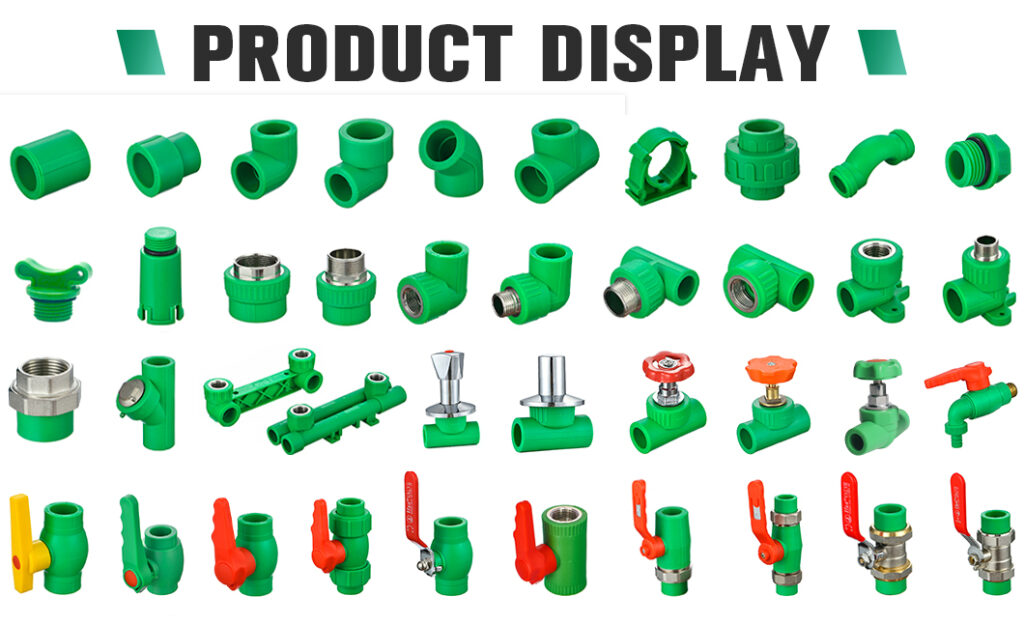Introduction
Polypropylene Random Copolymer (PPR) pipe fittings have gained popularity in the construction and plumbing industry due to their durability, versatility, and cost-effectiveness. PPR pipe fittings are an essential component of any plumbing system, and their usage extends to a wide range of applications across various industries. In this article, we will delve into the different types of PPR pipe fittings and explore their applications in diverse sectors, shedding light on the versatile and indispensable nature of these fittings.
Types of PPR Pipe Fittings
PPR Elbow Fittings:
PPR elbow fittings are designed to change the direction of the pipe, making them essential for complex plumbing systems. They are available in various angles, including 45 and 90 degrees, and are widely used in both residential and industrial applications. These fittings allow for smooth turns in the piping layout, ensuring efficient flow.ory 30+ years manufacture experience support color/size customization support free sample.Welcome to consult for catalog and free samples.This is our FacebookWebsite: www.facebook.com.
PPR Coupler Fittings:
Coupler fittings are used to connect two PPR pipes of the same diameter. They come in different sizes to accommodate various pipe dimensions and are crucial in ensuring a leak-free connection between pipe segments.
PPR Tee Fittings:
Tee fittings are used when a pipe needs to be divided into two separate lines. These fittings help in branching the pipeline, making them vital in systems where water distribution or mixing is required.
PPR Reducer Fittings:
Reducer fittings enable a transition from a larger pipe diameter to a smaller one or vice versa. They are commonly used in cases where a change in pipe size is necessary to maintain efficient flow rates.
PPR Ball Valve Fittings:
PPR ball valves provide an easy and convenient way to control the flow of water or other fluids. They are widely used in plumbing systems where on/off control is needed, ensuring efficient regulation of the fluid flow.
PPR End Cap Fittings:
End cap fittings are used to close off the end of a PPR pipe. They provide a secure and watertight seal, preventing debris and contaminants from entering the system. These are often used in the final stages of a plumbing network.
PPR Union Fittings:
Union fittings consist of three components – two female threaded ends and a union nut that can be unscrewed to separate the pipe connections. They are useful in systems that require periodic maintenance or disassembly.

Applications in Various Industries
Residential Construction:
PPR pipe fittings are extensively used in residential plumbing systems. Their lightweight, corrosion-resistant, and leak-proof properties make them ideal for transporting potable water, ensuring a clean and safe water supply for households.
Commercial Buildings:
PPR pipe fittings are equally valuable in commercial construction, where they play a critical role in ensuring the smooth operation of water supply, heating, and cooling systems. Their long-term durability and resistance to scaling make them a reliable choice.
Industrial Facilities:
Industries like manufacturing and processing plants often require robust plumbing systems. PPR pipe fittings can withstand the high pressure and temperature demands of industrial applications, making them indispensable for conveying various liquids and chemicals.
Agriculture:
In agriculture, PPR pipe fittings are used in irrigation systems to deliver water to crops efficiently. They are favored for their resistance to corrosion, which ensures the longevity of the irrigation system.
Chemical Industry:
PPR pipe fittings are suitable for handling chemicals due to their non-reactive nature. They are used to transport chemicals safely within industrial settings.
HVAC Systems:
Heating, ventilation, and air conditioning systems in both residential and commercial buildings rely on PPR pipe fittings for their non-corrosive nature, which ensures the longevity of the HVAC systems.
Swimming Pools and Aquatic Facilities:
PPR pipe fittings are commonly used in swimming pools and aquatic facilities for their resistance to chlorine and other pool chemicals. They ensure the proper circulation of water, maintaining pool hygiene.
Food Processing Industry:
PPR pipe fittings are ideal for the food industry, where hygiene is paramount. They are used for the distribution of potable water and other liquids in food processing plants.
Conclusion
PPR pipe fittings offer a wide range of options to meet the diverse needs of various industries. Their versatility, durability, and resistance to corrosion and scaling make them indispensable in residential, commercial, and industrial applications. Whether it’s ensuring clean water supply in homes, efficient irrigation in agriculture, or safe chemical transportation in industries, PPR pipe fittings play a crucial role in maintaining the infrastructure of our modern world. Understanding the different types and applications of PPR pipe fittings is essential for anyone involved in plumbing and construction.

